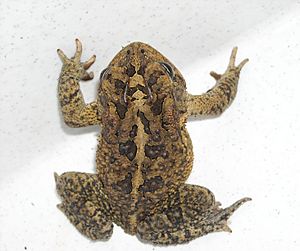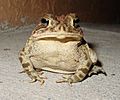Southern toad facts for kids
Quick facts for kids Southern toad |
|
|---|---|
 |
|
| Conservation status | |
| Scientific classification | |
| Genus: |
Anaxyrus
|
| Species: |
terrestris
|
| Synonyms | |
|
Bufo terrestris Bonnaterre, 1789 |
|
The southern toad (Anaxyrus terrestris) is a type of true toad found in the southeastern United States. You can find it from eastern Louisiana and southeastern Virginia all the way south to Florida. These toads often live in sandy areas. They are active at night and spend their days hiding in burrows. Southern toads are usually brown, but they can also be red, gray, or black. They grow to be about 8 cm (3 inches) long.
Contents
What Does a Southern Toad Look Like?
The southern toad is a medium-sized, plump toad. Females are a little bigger than males. They can be up to 9.2 cm (3.6 inches) long from their snout to their rear. A special feature of this toad is the bumps on its head. It also has spurs that point backward, reaching its paratoid glands. These glands are behind their eyes.
The toad's back and sides are covered with warts. Some of these warts might even be spiny. Their color can be brick red, or a mix of gray, brown, and black. Their belly is usually pale. Sometimes, they have dark spots on their chest.
Where Do Southern Toads Live?
Southern toads live on the coastal plain of the southeastern United States. Their home range stretches from southern Virginia down to Florida and Louisiana. There are also two smaller groups of these toads. These groups live in the Piedmont plateau and the Blue Ridge Mountains in South Carolina.
Southern Toad Behavior and Habits
Southern toads are active at night. During the day, they hide in a burrow they dig. Sometimes, they might hide under a log or a pile of leaves. You can find them in forests, on farms, and even in gardens. At night, they sometimes sit under outdoor lights. They do this to catch insects that are attracted to the light and fall to the ground. In winter, they might become less active. They can stay in their burrows for a long time during colder months.
Adult southern toads are carnivores. This means they eat meat. They hunt and eat any small invertebrates they can find. Invertebrates are creatures without backbones, like insects.
Southern Toad Reproduction and Life Cycle
Southern toads begin to breed in the spring. The males move from their higher ground homes to lower areas. They go to pools, ditches, swamps, and the edges of lakes to find mates. When it rains a lot, many male toads gather together. They start calling loudly, making a chorus of sounds.
Each female toad can lay up to 4,000 eggs. The water can become very thick with all the eggs. The eggs hatch into tadpoles. These tadpoles take about 30 to 55 days to grow. After this time, they change into tiny juvenile toads. These young toads are about 1 cm (0.4 inches) long. Tadpoles eat algae, which they scrape off plants underwater.
Conservation Status of the Southern Toad
The southern toad is found over a large area. It is common in most places where it lives. Because of this, the IUCN has listed it as being of "least concern". This means they are not currently worried about the toad becoming endangered.
However, in some parts of Florida, the southern toad has become less common. This is happening in areas where the cane toad has moved in. The cane toad is a different species that can compete with or harm native toads. Overall, the southern toad is good at adapting to different places. It does not face many big threats, and its population seems stable.
Gallery
-
Note the large parotoid gland
See also
 In Spanish: Sapo meridional para niños
In Spanish: Sapo meridional para niños





